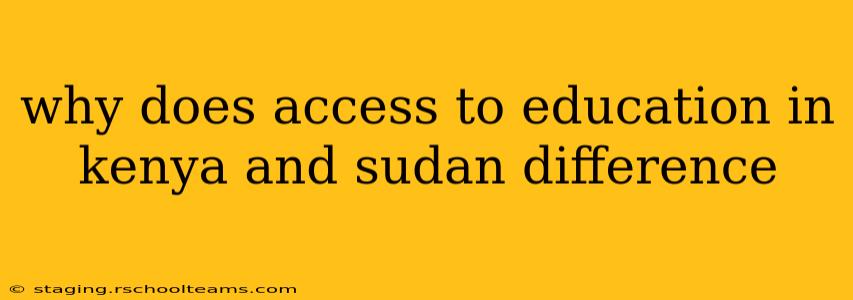Why Does Access to Education Differ in Kenya and Sudan?
Access to education in Kenya and Sudan, while both facing significant challenges, differs dramatically due to a complex interplay of factors. Understanding these discrepancies requires examining the historical context, political landscapes, economic situations, and social structures within each nation.
Historical Context and Political Stability:
Kenya has a longer history of investment in education, albeit unevenly distributed. Post-colonial governments, despite their shortcomings, prioritized building schools and establishing a basic education system, albeit with disparities between urban and rural areas. While Kenya's political landscape has had its share of instability, it has generally been more stable than Sudan's, allowing for somewhat more consistent educational policy and implementation.
Sudan, on the other hand, has experienced protracted periods of civil war, conflict, and political upheaval. These conflicts have devastated infrastructure, including schools, displaced populations, and disrupted educational systems. The ongoing political instability creates a volatile environment that makes long-term educational planning and investment incredibly difficult. Furthermore, the division of Sudan into Sudan and South Sudan further exacerbated existing challenges, leading to resource scarcity and competing priorities in both entities.
Economic Factors and Resource Allocation:
Kenya's economy, while not without its challenges, is generally more developed than Sudan's. This translates to greater government revenue available for investment in education, although the allocation of these resources remains a significant concern, with inequities between regions and socioeconomic groups. Private schools also play a larger role in Kenya, offering alternatives, albeit often inaccessible to the poorest populations.
Sudan faces severe economic constraints, exacerbated by decades of conflict and international sanctions. Limited resources mean that funding for education is severely restricted, leading to shortages of teachers, classrooms, textbooks, and other essential resources. Poverty also forces many children, particularly girls, out of school to contribute to household income.
Social and Cultural Factors:
In both countries, traditional gender roles and cultural practices can limit access to education, particularly for girls. Early marriage, child labor, and ingrained societal biases contribute to lower enrollment and completion rates for girls. However, Kenya has seen some progress in promoting girls' education compared to Sudan, although significant challenges remain.
Sudan's deeply ingrained tribal and religious differences also contribute to educational disparities. Conflict between different groups has disrupted education in many regions, and access to education often varies significantly based on ethnicity and religious affiliation. These social divisions hinder the development of a unified and equitable education system.
Infrastructure and Geographic Challenges:
Both Kenya and Sudan face geographical challenges in providing equitable access to education. Rural areas, often characterized by poor infrastructure and remoteness, are particularly underserved. Lack of transportation, inadequate facilities, and a shortage of qualified teachers further exacerbate these issues. However, Kenya has made more progress in addressing these challenges than Sudan, through initiatives to build schools in remote areas and provide teacher training.
People Also Ask Questions:
Q: What are the key differences in literacy rates between Kenya and Sudan?
A: While precise figures fluctuate depending on the source and year, Kenya generally demonstrates higher literacy rates than Sudan. This difference is largely attributed to the factors outlined above, including historical investment in education, political stability, and economic development. However, both countries still face significant challenges in achieving universal literacy.
Q: How does poverty affect access to education in these countries?
A: Poverty significantly impacts access to education in both Kenya and Sudan. Poor families often cannot afford school fees, uniforms, books, or transportation costs. Children from impoverished backgrounds may be forced into child labor or early marriage, further limiting their educational opportunities.
Q: What initiatives are being implemented to improve education in Kenya and Sudan?
A: Both countries are implementing various initiatives, though their effectiveness and scope differ significantly. Kenya has focused on initiatives aimed at expanding access to primary and secondary education, improving teacher training, and building schools in underserved areas. In Sudan, educational initiatives face greater challenges due to political instability and lack of resources, but various international organizations and NGOs are actively working to support education projects.
Q: Are there any significant differences in the types of education offered in Kenya and Sudan?
A: While both countries offer primary and secondary education, the quality and curriculum may differ. Kenya has a more established system with a greater emphasis on private education, while Sudan's system is often hampered by resource constraints and internal conflicts. Higher education opportunities also vary greatly in access and quality between the two countries.
In conclusion, the disparity in access to education between Kenya and Sudan is a multifaceted problem rooted in historical, political, economic, social, and geographical factors. While Kenya has made progress, significant challenges remain in both nations, requiring sustained effort and investment to achieve universal access to quality education.
